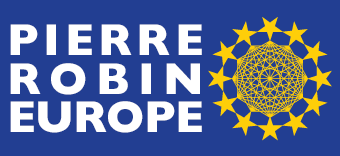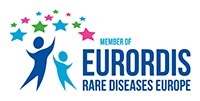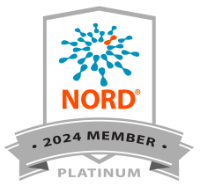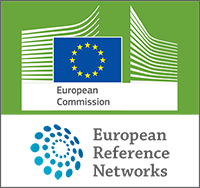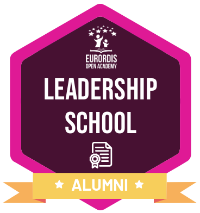Letter to Dutch Health Minister, 30 June 2021
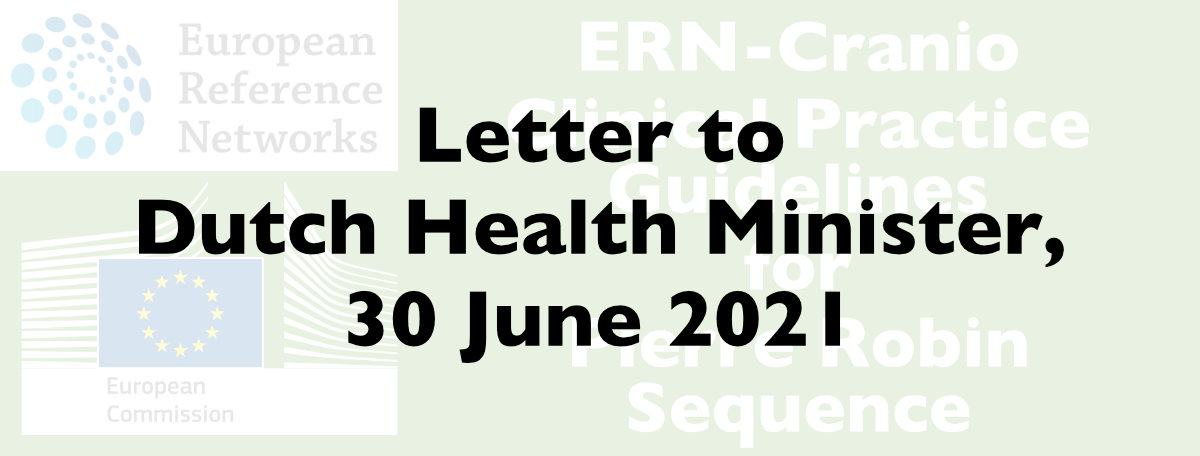
Letter to Dutch Health Minister, 30 June 2021
30 June 2021
Minister Tamara van Ark
Ministry of Health, Welfare and Sport
Postbus 20350
2500 EJ Den Haag
The Netherlands
Re: ERN-Cranio; Clinical Practice Guidelines for Pierre Robin Sequence/Syndrome
Dear Minister Tamara van Ark,
30 million rare disease patients here in Europe face profound hardships and daily challenges which most people could not even imagine. The European Reference Network (ERN) system was created to bring this community some measure of relief, by drawing upon the greatest rare disease experts throughout the EU. We at Stichting Pierre Robin Europe are members of Europe’s rare disease community; as part of our work, we advocate on behalf of newborn babies suffering from the rare disease, Pierre Robin Sequence / Pierre Robin Syndrome (PRS).
We are writing to you concerning ERN-Cranio, and the Clinical Practice Guidelines (CPGs) which ERN-Cranio is currently producing for PRS. These PRS CPGs will be the first international CPGs ever produced for this particular rare disease. They will therefore have a significant impact on PRS babies for years to come, and on the medical care these babies receive. We are writing to you to express serious concerns about the way this CPG project is being managed by Erasmus Rotterdam, where ERN-Cranio is based – and to formally request your official intervention. We will organize this letter under the following four headings, and provide further details below.
1. – Improper selection of healthcare providers in the Guideline Development Group
2. – Patients not included in the Guideline Development Group
3. – Efforts to address this situation amicably have failed
4. – The intervention we request
1. – Improper selection of healthcare providers in the Guideline Development Group (GDG)
The Guideline Development Group (GDG) for this CPG project is composed of some number of healthcare providers. We are not sure how many healthcare providers are in the GDG, or who they are, because ERN-Cranio has not permitted us to be a part of the GDG; indeed in the GDG for this project there are no patients and no patient organizations at all, which violates the EU’s Aragon Health Sciences Methodological Handbooks & Toolkit for Clinical Practice Guidelines (the Methodology). What we do know is that among the healthcare providers which have been included in the GDG, there are three in particular who are leading the project. The three healthcare providers which are leading the project are: (1) Erasmus Rotterdam; (2) Utrecht UMC; and (3) the Great Ormond Street Hospital in London. We will address each of these below.
1.1. – INCLUDED in the GDG: Erasmus Rotterdam
When drafting CPGs for a complex rare disease, the best available Centres of Expertise in Europe should be identified and brought in as members of the GDG. In the PRS CPG project, Erasmus Rotterdam is in the GDG, and is in fact one of the three healthcare providers which is leading the work. Erasmus Rotterdam is not one of Europe’s leading Centres of Expertise for PRS. Erasmus Rotterdam is not recognized as a PRS Centre of Expertise at all. Orphanet does not list Erasmus Rotterdam as a Centre of Expertise for PRS, and the Dutch Ministry of Health does not recognize Erasmus Rotterdam as a Centre of Expertise for PRS.
Erasmus Rotterdam is currently asking the Dutch Ministry of Health to accredit Erasmus Rotterdam as a Centre of Expertise PRS. In their application to the Dutch government they are asking the Dutch Ministry of Health to accredit Erasmus Rotterdam as a Centre of Expertise for both isolated Pierre Robin Sequence, ORPHA:718, and syndromic Pierre Robin Sequence, ORPHA:138044. As everybody in the rare disease community knows, rare disease patient volume is critical. This principle is so important that it is enshrined in the official Dutch law governing the Centre of Expertise accreditation procedure in the Netherlands:
“Het kandidaat ECZA adviseert aan, en behandelt voldoende patiënten om een bijdrage te kunnen leveren aan het verder ontwikkelen van kennis over de zeldzame aandoening en het verbeteren van de behandeling van een zeldzame aandoening. Het kandidaat ECZA moet bij een relevant percentage van het aantal bekende patiënten met de desbetreffende zeldzame aandoening in Nederland betrokken zijn in het zorgtraject.”
(“The candidate Centre of Expertise advises on, and treats enough patients to be able to contribute to the further development of knowledge about the rare disorder and to improve the treatment of the rare disorder. The Centre of Expertise candidate shall be involved in the care process in a relevant percentage of the number of known patients with the relevant rare disorder in the Netherlands.”)
At Erasmus Rotterdam, how many new ORPHA:718 isolated PRS patients were seen last year, meaning any and all new patients, ranging in age from newborn babies, all the way up to 18 years? Erasmus Rotterdam saw one isolated PRS patient.
Erasmus Rotterdam is also seeking accreditation as a Centre of Expertise for syndromic Pierre Robin Sequence, ORPHA:138044. How many new ORPHA:138044 syndromic PRS patients were seen last year, once again any new patients, ranging in age from newborn babies, all the way up to 18 years? Erasmus Rotterdam saw one syndromic PRS patient, again just one single patient.
These figures cannot be explained by COVID-19; during the same time period, the same Erasmus Rotterdam unit welcomed over 30 new cleft lip/cleft palate patients. Erasmus Rotterdam’s new patient volume for isolated PRS was just one patient, and for syndromic PRS was just one patient, and on the basis of this patient volume, which hovers just above zero, Erasmus Rotterdam seeks official accreditation from the Dutch Ministry of Health as a Centre of Expertise for this complex, heterogenous, life threatening rare disease.
In Erasmus Rotterdam’s application to the Dutch Ministry of Health requesting accreditation as a PRS Centre of Expertise, the application asks if there are any international CPGs for PRS, and if so, whether Erasmus Rotterdam contributed to them. In response Erasmus Rotterdam explains that PRS guidelines are being developed, and that Erasmus Rotterdam is the coordinating centre for this guideline development project. Thus: Erasmus Rotterdam has very low PRS patient volume, and is not a Centre of Expertise for PRS; therefore Erasmus Rotterdam should not be drafting CPGs for PRS. Nevertheless, Erasmus Rotterdam placed itself as the key healthcare provider in this PRS CPG drafting project. Then, after placing itself as the key healthcare provider in the PRS CPG drafting project, Erasmus Rotterdam, using circular logic, tells the Dutch government that this key role which Erasmus Rotterdam is playing is itself evidence of Erasmus Rotterdam’s PRS expertise, and therefore the Dutch Ministry of Health should officially accredit Erasmus Rotterdam as a Centre of Expertise for PRS.
Rare disease patients in the Netherlands are told that the official Dutch procedure for accrediting rare disease Centres of Expertise guards against “self-accreditation”. Self-accreditation should never be permitted, the Dutch Ministry of Health says, because self-accreditation leads to sub-optimal Centres of Expertise; sub-optimal Centres of Expertise lead, in turn, to sub-optimal ERNs. We agree with you.
While this particular situation involves the rare disease PRS, it nevertheless raises fundamental questions which apply to other rare diseases, other Centres of Expertise, and the ERN system in general. How many PRS Centres of Expertise does a small country like the Netherlands actually need? How many PRS Centres of Expertise would make the most sense, and provide the greatest healthcare benefit, to this very small rare disease patient population in the Netherlands? Finally, if every healthcare provider really is a PRS rare disease Centre of Expertise, as they claim, then why do we bother with the Orphanet “Centre of Expertise” designation – why should we even have an ERN system?
The reality is that ERN CPGs have profound consequences for actual living human beings. In this case the patients affected will be newborn babies with PRS. These newborn babies suffer from a life threatening rare disease which is characterized by significant morbidity, and significant mortality. In CPG development only the most highly qualified Centres of Expertise should be involved; CPG development is no place for on the job training, credential building exercises, or professional politics. Erasmus Rotterdam is without question a highly qualified Centre of Expertise for other rare diseases, but rare diseases are notoriously complex, and even deep expertise in one rare disease does not confer expertise in another. Erasmus Rotterdam is not a Centre of Expertise for PRS; this is an objective fact. Nevertheless ERN-Cranio’s Coordinator at Erasmus Rotterdam appointed Erasmus Rotterdam as the lead healthcare provider in this PRS CPG development project. At Stichting Pierre Robin Europe we have a legal duty to represent the interests of PRS babies, and we are gravely concerned about this state of affairs.
1.2. – INCLUDED in the GDG: Utrecht UMC
As noted above, the PRS patient volume at Erasmus Rotterdam is very low. However in terms of population, the city of Rotterdam, which has approximately 650,000 people, is almost twice the size of the city of Utrecht, which has approximately 350,000 people. Once again for the purpose of developing highly specialised expertise in the treatment of any complex rare disease, especially a complex rare disease as heterogenous as PRS – at least half of PRS babies also suffer from an associated condition – patient volume is critical. If Erasmus Rotterdam’s PRS patient volume is already very low, with Rotterdam’s population of 650,000, then what can we expect of Utrecht UMC’s PRS patient volume, with Utrecht’s population of 350,000?
Even more importantly: what happened to Amsterdam? Rotterdam and Utrecht are two relatively small cities in the Netherlands, which is a relatively small EU Member State; Amsterdam’s population is by far the highest of any city in the Netherlands, and is substantially higher than the population of Rotterdam and Utrecht combined. Amsterdam UMC likely has higher PRS patient volumes than any other hospital in the Netherlands. Amsterdam UMC is indeed an Orphanet Centre of Expertise for PRS. Furthermore at Amsterdam UMC we find the most internationally recognized PRS expert in the Netherlands, Dr. Corstiaan Breugem. However, ERN-Cranio has kept Dr. Breugem and Amsterdam UMC completely out of this PRS CPG project. We will return to this subject of Amsterdam UMC shortly, after discussing the third leading healthcare provider in the GDG, the Great Ormond Street Hospital in London.
1.3. – INCLUDED in the GDG: Great Ormond Street Hospital in London
The Great Ormond Street Hospital in London (GOSH London) is not a member of ERN-Cranio. Nevertheless GOSH London is in the GDG, and indeed they are playing a leading role in the development of these CPGs. On this subject, the following points must be considered.
GOSH London is not a member of ERN-Cranio. However, in order to be a member of a CPG project’s GDG, GOSH London does not have to be a member of ERN-Cranio. The EU’s Methodology makes it clear that the healthcare providers in the GDG can be healthcare providers which are in the ERN, as well as healthcare providers which are not in the ERN. As the Methodology explains, the GDG has four key constituents, one of which is healthcare professionals; these can be
“members of the corresponding European Reference Network (ERN) and, depending on the disease, any other professional, usually involved in the care of the patient with the rare condition”.
The Methodology does not require membership in an ERN to be a member of the ERN’s GDG for a CPG development project.
The goal is to produce the best possible CPGs. To produce the best possible CPGs, the ERNs must draw upon the most highly qualified rare disease Centres of Expertise in Europe. It is therefore fortunate that the Methodology does not require ERN membership as a condition for being a member of a CPG project’s GDG; it would bring no benefit to rare disease patients to exclude highly qualified rare disease Centres of Expertise, simply because they are not members of the ERN. Furthermore it is an unfortunate fact that not all of the ERN system’s members are Europe’s most highly qualified rare disease experts. As part of the 2017 launch of the ERN system, 953 healthcare providers across all of Europe applied to become members of the various ERNs. Of the 953 healthcare providers which applied to become members of the ERN system, 952 were accepted, an admission rate of 99.895%. When 953 healthcare providers declare themselves to be highly specialised rare disease experts, and only one single healthcare provider is rejected, with an admission rate of 99.895%, then we do not have a quality control procedure, we have a self-accreditation procedure.
In the EU’s ECA Special Report 7/2019, “EU actions for cross-border healthcare”, the EU’s European Court of Auditors (ECA) confirmed this. The ECA carefully studied the assessment procedure which was used when deciding which healthcare providers would become members of the ERN system. Based on their detailed analysis, the ECA came to the following conclusion: “The final outcome of the assessment process was that 952 Healthcare Providers out of the 953 that applied were accepted into the ERNs. We conclude in practice that this assessment process added limited value to the establishment of the ERNs.” For those outside of Europe, such ineptitude may draw a cynical smile. For us rare disease patients it was a catastrophe. We know how critical it is to have only the most highly qualified rare disease experts on board. We also know that it is significantly easier to permit underqualified healthcare providers to become members, than it is to slowly and painstakingly draw them out. In any case the Methodology permits GOSH London be a member of the GDG, even though GOSH London is not a member of ERN-Cranio. The only caveat here is that GOSH London is not in the EU, and this CPG project is an EU-funded project.
1.4. – EXCLUDED from the GDG: Amsterdam UMC
Dr. Corstiaan Breugem of Amsterdam UMC is one of the leading Pierre Robin Sequence experts in the world (Prof. Dr. Corstiaan Breugem, Head of Pediatric Plastic Surgery at Amsterdam UMC, Emma Children’s Hospital; President of the Dutch Cleft Palate Craniofacial Association; Vice-President of the European Cleft Palate Craniofacial Association; c.c.breugem@amsterdamumc.nl). Based on his strong interest in Pierre Robin Sequence (PRS), which dates back many years, Dr. Breugem organized the world’s first International Consensus Meeting on Pierre Robin Sequence:
http://www.robinsequence.nl/sites/robinsequence/downloads/FinalProgram.pdf
The international PRS consensus movement which Dr. Breugem created and which he continues to develop represents only one aspect of the immense amount of work which Dr. Breugem has carried out on behalf of PRS babies. The volume of PRS studies which Dr. Breugem has authored/co-authored sets him apart from virtually any PRS expert not only in Europe but in the world. A PubMed search indicates that Dr. Breugem has authored/co-authored 27 papers on Robin Sequence. 27 papers is a remarkable body of research considering the fact that PRS is a rare disease; Stichting Pierre Robin Europe knows of no PRS expert who has published more:
https://bit.ly/breugem-prs
The EU Methodology states that when drafting CPGs, ERNs should be “using limited resources more efficiently by building on existing efforts”. In spite of Dr. Breugem’s existing efforts, which are basically incomparable, and influential, and long term, and in spite of Dr. Breugem’s unquestionably profound knowledge of this complex rare disease, ERN-Cranio has excluded Dr. Breugem from this PRS CPG development project’s GDG.
To avoid any misunderstanding, we are not saying that Dr. Breugem and Amsterdam UMC, his Orphanet PRS Centre of Expertise, are not one of the three leading healthcare providers in the GDG (those are Erasmus Rotterdam, Utrecht UMC, and GOSH London). We are saying that Dr. Breugem and Amsterdam UMC are not members of the GDG at all. They are completely excluded, out altogether.
There is no possible justification for excluding this world class PRS expert, Dr. Corstiaan Breugem of Amsterdam UMC, from the GDG to develop CPGs for this complex rare disease. His absence is shocking. Dr. Breugem is one of Europe’s leading authorities on PRS; certainly no Dutch PRS expert has contributed more, or published as many studies, or tried harder, to move things forward for this highly vulnerable rare disease population. Apparently ERN-Cranio’s Coordinator at Erasmus Rotterdam – which is not a PRS Centre of Expertise – considers it natural to recruit into this EU-funded PRS CPG project a hospital which is not even in the EU – GOSH London – while at the same time excluding a world-renowned PRS expert and Orphanet PRS Centre of Expertise located just 80 kilometres away, in Amsterdam. How? Why? What good can possibly come of this? Once again, Stichting Pierre Robin Europe has a legal duty to represent the interests of PRS babies; we are gravely concerned. We find this situation incomprehensible.
1.5. – EXCLUDED from the GDG: Tübingen University Hospital
Dr. Christian Poets is another internationally recognized PRS expert (Prof. Dr. Christian F. Poets, Department Head at the Tübingen University Hospital, Department of Neonatology; christian-f.poets@med.uni-tuebingen.de). Dr. Poets is with the Tübingen University Hospital in Germany, an Orphanet PRS Centre of Expertise. Dr. Poets manages the team which administers the highly specialised, medically proven, safe, non-surgical, cost-effective Tübingen Palatal Plate treatment. The Tübingen Palatal Plate was specifically developed to treat babies with this rare disease, PRS. Using the Tübingen Palatal Plate, the Tübingen University Hospital has successfully treated PRS babies from throughout Europe, Russia, even the United States of America. These babies were transported by ambulance and even flown in, from other countries, to Tübingen Germany, for the express purpose of receiving the highly specialised, medically proven, safe, non-surgical, and cost-effective PRS treatment, the Tübingen Palatal Plate.
Based on its medically proven ability to safely resolve the PRS baby’s life threatening breathing difficulties – without surgery – Stanford University has already adopted the Tübingen Palatal Plate treatment. Dr. Poets and his highly specialised multidisciplinary team of PRS experts in Tübingen provided Stanford with careful guidance, instruction and support.
Dr. Poets and his colleagues at the Tübingen University Hospital are now training experts at Harvard University how to offer the Tübingen Palatal Plate treatment to PRS babies at Harvard/Boston Children’s Hospital. The Tübingen Palatal Plate, which safely and effectively resolves the Pierre Robin Sequence baby’s breathing difficulties, without the need for painful surgery, represents a breakthrough in PRS care. It is having a considerable impact on international clinical practice by inspiring PRS experts everywhere, including PRS experts at the top research hospitals in the United States of America – Stanford and Harvard – to rethink longstanding PRS treatment practices.
In internationally peer-reviewed PRS research, Dr. Poets and the Tübingen University Hospital have played a leading role. Once again, the volume of papers authored/co-authored by Dr. Poets sets him apart from the overwhelming majority of international PRS experts. A PubMed search indicates that Dr. Poets has authored/co-authored no less than 19 papers on Robin Sequence, once again a remarkable body of research when one considers that PRS is a rare disease:
https://bit.ly/poets-prs
Furthermore the studies authored by Dr. Poets and his colleagues at the Tübingen University Hospital are evidence-based; they rely upon polysomnography to measure PRS upper airway obstruction both pre-treatment and post-treatment. Virtually everyone agrees on the importance of practicing evidence-based medicine, using objective criteria, and virtually everyone agrees that polysomnography is the gold standard for measuring the severity of upper airway obstruction in PRS babies. Nevertheless a substantial percentage of PRS studies simply ignore polysomnography altogether. Dr. Poets and his multidisciplinary team of highly specialised PRS experts at the Tübingen University Hospital, by consistently focusing on objective criteria, have raised the bar for evidence-based PRS research.
From the very beginning of the international PRS consensus movement launched by Dr. Breugem, Dr. Poets has played a leading role. The world’s Third International Consensus Meeting on Pierre Robin Sequence is being organized by Dr. Poets. It will take place in Tübingen Germany in 2022. It was supposed to take place in 2020, but it was delayed due to COVID-19:
https://robin-sequence.de/
Elsevier’s “Seminars in Fetal-Neonatal Medicine” decided to dedicate a full issue of their respected medical journal to PRS. Based on the Tübingen University Hospital’s world-renowned reputation for PRS treatment and research, Elsevier chose the Tübingen University Hospital to serve as guest editor for this upcoming PRS edition.
Thus: the Tübingen University Hospital, an Orphanet PRS Centre of Expertise, has high PRS patient volume; they routinely receive and successfully treat PRS babies from both inside and outside of Germany; they have produced an exceptionally high volume of high quality PRS research; they have played a fundamental and leading role in the international PRS consensus movement; they were selected to host the world’s Third International Consensus Meeting on Pierre Robin Sequence; they have shared their highly specialised breakthrough PRS treatment with Stanford and they are currently sharing it with Harvard; Elsevier publishing company chose them to serve as editors of the upcoming “Seminars in Fetal-Neonatal Medicine” edition which will be devoted to PRS… and yet ERN-Cranio decided that Dr. Poets / the Tübingen University Hospital must not be a member of the GDG.
To be clear, we are not saying that Dr. Poets and the Tübingen University Hospital are not one of the three leading healthcare providers in the GDG (Erasmus Rotterdam, Utrecht UMC, and GOSH London). We are saying that Dr. Poets and the Tübingen University Hospital are not in the GDG at all. They are absolutely out, just as Dr. Breugem and Amsterdam UMC are absolutely out.
When it comes to the pooling of the EU’s rare disease knowledge and expertise, the Atlantic Ocean separating Europe from the United States of America may prove itself to be more transversable than the internal borders separating different EU Member States. According to the 2011 Cross-border Healthcare Directive, the EU’s European Reference Networks for rare diseases are supposed to “help realise the potential of European cooperation regarding highly specialised healthcare for patients and for healthcare systems by exploiting innovations in medical science and health technologies.” By excluding the Tübingen University Hospital from the GDG, Erasmus Rotterdam, an official recipient of EU funds, may be violating the 2011 Directive, and turning the spirit of the ERN system on its head.
2. – Patients excluded from Guideline Development Group
The EU’s Aragon Health Sciences Methodological Handbooks & Toolkit for Clinical Practice Guidelines (the Methodology) states that patients should be included in the Guideline Development Group (GDG) which creates CPGs. The Methodology states that the GDG has four key constituents, the second of which is patients:
“Composition of the Guideline Development Group.
The guideline development group (GDG) must be multidisciplinary, with representation of the expertise and views relevant to the particular needs of the guideline. Although it is likely that one professional group may dominate, comprehensive stakeholder involvement is as important to the development of guidelines for rare diseases as it is for common diseases… The GDG has four key constituents:
1) Healthcare professionals…
2) Patients…”
…
The EU Methodology lists “Patients” as the second most important constituent in the GDG. The AGREE II instrument, one of the world’s most widely employed and internationally validated grading systems for assessing the methodological quality of CPGs, also states that patients should be in the GDG, which AGREE II refers to as the “working group”.
In correspondence with ERN-Cranio’s Coordinator, Dr. Irene Mathijssen, Dr. Mathijssen confirmed that ERN-Cranio is bound to respect the Methodology. Dr. Mathijssen wrote that:
“As a rule, an ERN guideline is developed according to the official and mandatory scientific methodology supervised by a professional organisation.”
ERN-Cranio has permitted no patients, and no patient groups, in the GDG. This violates both the Methodology, and the AGREE II instrument.
The Methodology requires that patients be in the GDG; it is not enough for healthcare providers in the GDG to speak with patients, or reach out to patients. Patients must be in the GDG, they are one of the four key constituent members of the GDG. We, Stichting Pierre Robin Europe, and the other ePAG patient organization which ERN-Cranio committed to include in this work, have both been excluded from the GDG.
We estimate that this PRS CPG project began in late 2020. We cannot be certain. We have never been CC’d on any email sent out to the GDG’s members concerning this CPG development project. We have never been invited to any telephone conference call or video conference. We have not received a copy of the GDG’s agenda, or work schedule. We are not included in the GDG’s email recipient list.
We were not told about the initial meetings of the GDG. We do not know when the initial meetings took place – sometime last year, we guess. The Methodology emphasizes how important these first GDG meetings are:
“The first meeting of the GDG is very important because the operating rules are set up and the roles and functions of each member are defined. The first meeting can also generate the conditions for developing a good group dynamic… The second meeting can focus on agreeing the clinical questions, based on the scope.”
We were excluded from all of these initial meetings. And we never received any documents or minutes from these meetings. Also from the Methodology:
“Particular attention should be paid to the needs of the patients with rare diseases of the GDG when scheduling and organising meetings, as they may have ongoing health conditions that will impact their ability to engage.”
There was need for the GDG’s members to consider our schedules, because ERN-Cranio excluded us from the GDG altogether.
According to the Methodology, the GDG uses the initial meetings to discuss the clinical questions which the CPGs will address. What are the clinical questions which these CPGs will address? ERN-Cranio excluded us from the GDG, so we do not know. However according to the Methodology, we the patients should have been involved in this very important process, of defining the clinical questions:
“During the first meeting(s) of the GDG, the content experts (clinical experts, policy makers, etc.) and the patients and carers inform the development of the detailed clinical questions and may contribute additional questions. The list of clinical questions must be agreed by all GDG members.”
In the discussion and development of the clinical questions, we, Stichting Pierre Robin Europe, ERN-Cranio’s official ePAG patient organization for PRS, were supposed to share perspectives on patient outcomes: symptoms, adverse events, burdens, demands on caregivers, restrictions on lifestyle, quality of life… this did not happen.
The Methodology states that our agreement on the final list of clinical questions was required; “The list of clinical questions must be agreed by all GDG members.” Never mind the fact that we never agreed on the final list of the CPG’s clinical questions – we still do not even know what the clinical questions are.
In rating the importance of outcomes, our involvement as a patient organization was again necessary, as explained by the Methodology:
“Before starting an evidence review to answer a clinical question, the GDG should apply an initial rating to the importance of outcomes, according to GRADE methodology, in order to identify which outcomes of interest are both critical to decision-making and important to patients.”
All of these activities above were discussed by the GDG’s members, planned, carried out, and completed, without us, the patients. The patient’s experience, concerns, knowledge, values, preferences, goals, fears – everything the patient knows, wants, thinks, and feels – the patient perspective itself – was excluded.
In a recent paper which ERN-Cranio’s Coordinator Dr. Irene Mathijssen co-authored, “European Reference Networks: challenges and opportunities”, one of the sections is titled “Patient-centeredness in ERNs”. It opens with:
“Increasing patient-centeredness is a general trend in healthcare, but in RD area, it is of special importance…”
Everybody already knows that patient-centeredness is important, and this is why it is built into the EU Methodology which the EU paid Aragon Health Sciences Institute to develop, for the EU’s ERN system, for the express purpose of creating ERN Clinical Practice Guidelines for rare diseases. The ERN Methodology explicitly requires that patients be members of the GDG, and that they be directly involved in the creation of an ERN’s CPGs from the very beginning of the CPG development process. ERN-Cranio has been running this CPG project now for three months, six months, nine months, we do not know how long; one of the physicians involved in this project indicates on his LinkedIn profile that he has been working on these ERN guidelines for PRS since September 2020, which was 10 months ago. Whenever it began, we have been excluded completely, in violation of the EU Methodology.
3. – Efforts to address this situation amicably have failed
Our correspondence with ERN-Cranio demonstrates that we have tried to address these issues amicably, first by communicating directly with ERN-Cranio’s Coordinator, and then by asking outside parties to intervene. These efforts have failed; we will provide further details below.
Stichting Pierre Robin Europe has been an ePAG patient organization in ERN-Cranio since 2018. We received repeated assurances over the years that the CPG project would soon begin, and that we would be actively involved. In April 2021 Stichting Pierre Robin Europe received the following message from ERN-Cranio Project Manager Renée de Ruiter:
From: R. de Ruiter, r.deruiter.1@erasmusmc.nl
Date: Wed, Apr 21, 2021 at 2:32 PM
Subject: update ERN CRANIO guideline Robin Sequence
To: pakter@pierrerobineurope.com
Cc: O.K.C. Spivack, o.spivack@erasmusmc.nl
Dear Philippe,
I would like to inform you that ERN CRANIO has started the development of a European Guideline on Robin sequence. The project is led by Erasmus MC as ERN CRANIO coordinating centre and involves all ERN CRANIO expert centres for RS. As part of this process we will contact patients/families via the ERN CRANIO centres involved to identify bottlenecks in organization of care for patients with Robin sequence.
Best regards,
Renée de Ruiter
Project manager ERN CRANIO, Erasmus MC Rotterdam
The other ePAG patient organisation which ERN-Cranio promised on multiple occasions to include in this PRS CPG development project did not receive the above message at all; we had to forward the message to them.
The next day we sent a detailed message directly to ERN-Cranio’s Coordinator, expressing our concerns. That detailed message can be read in its entirety over here.
We found it disappointing that the patient’s role in this CPG development process was limited to providing feedback on one narrow and specific question: “bottlenecks” in care. As we explained to Dr. Mathijssen, “the email indicates that you plan to contact patients/families via the ERN-Cranio centres to identify bottlenecks in care. Bottlenecks in care – is this the limit of patient involvement in the development of these Guidelines, which are so critical for us, the patients? We are limited to commenting on bottlenecks, without being permitted to contribute anything meaningful or participate in any way to a discussion of THE CARE ITSELF? Have you no interest in Pierre Robin Sequence parental concerns, treatment preferences, goals, fears, patient perspectives on burden of care, quality of life, nothing of this sort, just bottlenecks?”
One week later we received a response from ERN-Cranio’s Coordinator, Dr. Irene Mathijssen:
From: I.M.J. Mathijssen <i.mathijssen@erasmusmc.nl>
Date: Thu, Apr 29, 2021 at 9:38 PM
Subject: RE: update ERN CRANIO guideline Robin Sequence
To: Philippe Pakter <pakter@pierrerobineurope.com>
Cc: R. de Ruiter <r.deruiter.1@erasmusmc.nl>, O.K.C. Spivack <o.spivack@erasmusmc.nl>, Anne-Laure Aslanian <anne-laure.aslanian@eurordis.org>, Neil Russell <russell@pierrerobineurope.com>
Dear Philippe,
For some time, the members of ERN CRANIO indicated an interest in developing a guideline on Robin sequence. It took a long time before it became clear that the EC guideline tender did not include finances to develop a guideline, but was mainly directed at training care providers in guideline development. To overcome this hurdle, we have obtained permission from the EC to reserve a part of the management-budget of ERN CRANIO to develop the Robin guideline.
As a rule, an ERN guideline is developed according to the official and mandatory scientific methodology supervised by a professional organisation. The same procedure was followed for the ERN guideline on craniofacial microsomia. As part of this procedure, patient input is requested via all participating ERN Centres with expertise in treating Robin sequence. This offers us a view on the bottlenecks that parents and patients encounter in the care per country. This is important given the different organisation of care for these patients per country. At present, we have collected nearly 100 responses.
Next to this, a systematic review of the literature is undertaken by the three leading Centres of London, Utrecht and Rotterdam. This will result in a draft version of the guideline that is open for comments to all ERN CRANIO members, including yourself.
Regards,
Irene Mathijssen, Aebele Mink van der Molen, Neil Bulstrode, Eppo Wolvius
Based on Dr. Mathijssen’s response, we now knew that the three healthcare providers which would be leading this PRS CPG project would be Erasmus Rotterdam, Utrecht UMC, and GOSH London. We did not know what other healthcare providers were involved. We still had no idea when the project began, and we could not understand why we were only finding out about it now. What was clear from this message was that this PRS CPG project was well underway. ERN-Cranio had excluded us from all of the work which the members of the GDG had already completed to determine the scope, develop the clinical questions, discuss patient outcomes, discuss the importance of these outcomes, discuss the work plan, and begin the research.
In the message above, ERN-Cranio’s Coordinator told us that we would be permitted to comment on the draft of the CPGs, once the draft had been written. When a draft document has been discussed, outlined, researched, and written, it achieves a momentum which makes it naturally resistant to change. Furthermore, permitting someone to provide feedback on a written draft is not the same thing as inviting that party in at the beginning of the process, so that they can actively and meaningfully contribute before the draft is written. In this context, active and meaningful participation means membership in the GDG – that is, the GDG whose members discuss the scope, develop the clinical questions, agree on the clinical questions, discuss patient outcomes, discuss the importance of those outcomes, discuss the work plan, go through all of these and other critical steps. ERN-Cranio excluded us from all of this.
At this point we reached out to the European Organisation for Rare Diseases (EURORDIS), to request mediation. After receiving our request for mediation, Ms. Inés Hernando, the EURORDIS ERN and Healthcare Director, contacted ERN-Cranio’s Coordinator. Shortly thereafter, Ms. Hernando provided us with the following report:
“I had a call earlier this week with Irene to share with her your request. She mentioned that she had replied to your email explaining that the ERN will follow a validated methodology for the development of the CPG.”
ERN-Cranio told Ms. Hernando of EURORDIS essentially the same thing that ERN-Cranio had already told us: ERN-Cranio is following the Methodology.
We then decided to approach a different ERN in the EU’s ERN system. We requested a conference call with the Coordinator; this ERN Coordinator, who was intimately familiar with the Methodology, confirmed that patients are supposed to be involved as active participants in the CPG development process from the very beginning, from day one.
Stichting Pierre Robin Europe is a Dutch stichting. Being legally based in the Netherlands, Stichting Pierre Robin Europe, in addition to being a member of EURORDIS, is also a member of Vereniging Samenwerkende Ouder en Patiëntenorganisaties (VSOP), the Dutch Patient Alliance for Rare and Genetic Diseases. We reached out to VSOP’s Director, Dr. Cor Oosterwijk. We explained that the top priority was to immediately involve, in the CPG development project’s GDG, two of the EU’s most highly respected Orphanet PRS Centres of Expertise, Amsterdam UMC, and the Tübingen University Hospital. We emphasized that these two Orphanet PRS Centres of Expertise should be included in the GDG before the draft CPGs were written – not after the draft CPGs were written, but before. The second priority was for ERN-Cranio to include patients as members of the GDG, as required by the EU Methodology. VSOP’s Director, Dr. Oosterwijk, contacted ERN-Cranio. ERN-Cranio’s Coordinator informed Dr. Oosterwijk that “the current procedure will not be changed”.
4. – The intervention we request
Concerning healthcare providers: PRS babies need and are entitled to the very best CPGs possible. To produce the best possible CPGs, the GDG for this guideline development project must include the most highly qualified PRS experts in the EU. ERN-Cranio at Erasmus Rotterdam has completely excluded, from the GDG, two world class PRS experts, Dr. Corstiaan Breugem of Amsterdam UMC, and Dr. Christian Poets of the Tübingen University Hospital. There is no possible justification for this; their exclusion is astonishing. It almost appears as if they are being punished for their exceptional PRS expertise. Nothing good can come from their exclusion; absolutely no benefit can be gained by keeping them out. All Erasmus Rotterdam is doing by excluding them is compromising the quality of the PRS CPGs, at the expense of PRS babies. For the sake of PRS babies – not for the sake of the professionals involved, but simply for the sake of these PRS babies – Dr. Corstiaan Breugem of Amsterdam UMC, and Dr. Christian Poets of the Tübingen University Hospital, both highly respected EU Orphanet PRS Centres of Expertise, must immediately be brought in as members of this Pierre Robin Sequence CPG project’s GDG. Whatever regrettable reason Erasmus Rotterdam may have had for excluding these two world class experts, this is beside the point. The important thing now is to immediately bring both of them into the GDG, in order to produce the best possible CPGs for this complex rare disease.
Concerning patient representation: the EU Methodology states that patients should be included in an ERN’s CPG development project’s GDG from the very beginning. Patients should be full members of the GDG, in the room, sitting at the table, alongside the other GDG constituents. Stichting Pierre Robin Europe should immediately be brought in as a member of this Pierre Robin Sequence CPG development project’s GDG. When an email is sent out to members of the GDG, we as members of the GDG should receive the message. When a conference call is organized, we should be invited to participate in the conference call. When a video conference is scheduled, we should receive a link to the video conference. When an agenda is produced, we should receive a copy of the agenda. We must immediately be brought in as members of this PRS CPG development project’s GDG. This is not complicated or obscure. If you want to involve patients in healthcare, all you have to do is invite them in – not exclude them at every possible turn.
Minister Tamara van Ark, we are not asking for the opportunity to participate in the process of external review. We are not asking for the chance to provide feedback on work which the actual members of the GDG have already carried out. We seek inclusion in the GDG, and full recognition as members of the GDG, for ourselves – Stichting Pierre Robin Europe – and Dr. Breugem, and Dr. Poets. The Methodology makes it clear that being part of the external review group, and being an actual member of the GDG, are two separate and distinct things. Members of the GDG run the project, make the decisions, and do the work; they discuss and formulate and prioritize the questions, they carry out the research, and they draft the document. Members of the external review group come in after the fact. The GDG is under no obligation whatsoever to incorporate any of the feedback which the GDG receives from external reviewers; the GDG does not even have to respond to those who are providing the feedback, regardless of how serious the concerns may be. From the Methodology: “All external reviewers’ comments will be considered by the GDG who will ultimately decide whether they are incorporated or not… It is not necessary to respond to every single comment individually.” Once again we seek full and prompt inclusion as members of this CPG development project’s GDG.
Minister Tamara van Ark, as this is a matter of ongoing urgency – the work on these CPGs is already well underway – we would welcome the opportunity to meet with you in person in Den Haag or elsewhere to discuss this complaint in person. We look forward to hearing from you. Thank you.
Kind regards,
Philippe Pakter
Stichting Pierre Robin Europe, voorzitter
Member, EURORDIS, The European Organisation for Rare Diseases
Member, VSOP, Vereniging Samenwerkende Ouder-en Patiëntenorganisaties, The Dutch Patient Alliance for Rare and Genetic Diseases
PhD candidate, law, the University of Geneva: “Access to healthcare in Europe: the effectiveness of EU legislation in the context of rare disease patients”
